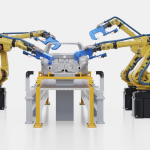As fulfillment demands spike ahead of peak seasons, many warehouses wait for disruption to expose their weakest links. But that approach is changing. Companies are now building digital twins of their intralogistics systems, virtual replicas that allow them to simulate congestion, test picking sequences, and preempt failure before it happens.
By using AI-enabled twins that mirror layout, task sequences, and real-time constraints, companies are shifting from post-mortem analysis to pre-season scenario planning. The result: better resilience, fewer surprises, and higher throughput when it counts.
From Intuition to Simulation
Traditional capacity planning relied on historical data, rough volume forecasts, and manual labor models. But the complexity of today’s high-mix, high-speed environments—especially with robotic fleets and dynamic slotting—demands a more adaptive approach.
Digital twins allow fulfillment leaders to stress test operations by virtually injecting spikes in volume, varying SKU mixes, or simulating labor shortages. DHL Supply Chain has deployed such simulations in several European and North American facilities, testing various inbound and outbound flows ahead of promotional surges. These models allow them to tweak picking sequences, reassign AMRs, or reconfigure staging zones—before inefficiencies surface in real life.
Invia Robotics, whose fleet management software powers AMR operations across dozens of warehouses, enables users to model alternative task paths and queue patterns. Customers can run hour-by-hour simulations under different load scenarios, pinpointing when and where tasks begin to stack or pick lanes become congested. The system then recommends routing or schedule shifts to keep workflows fluid.
This approach flips the paradigm: instead of planning for best-case efficiency, logistics teams now test for worst-case resilience.
The New Digital Twin Stack
Layout-Aware Process Mapping: Twins ingest warehouse CAD data, real-time traffic patterns, and task dependencies to accurately model floor-level interactions. Congestion risk isn’t based on averages—it’s spatially modeled.
Scenario-Based Load Injection: Users simulate peak-hour order waves, staff shortfalls, or dock-inventory mismatches. Systems identify bottleneck onset thresholds and quantify how long before service levels slip.
Robot Behavior Modeling: AMR logic—charging cycles, idle thresholds, reroute logic—is replicated in the twin. This ensures simulation results translate to real-world behavior, not theoretical assumptions.
Operational Heat Mapping: Visual dashboards highlight zones under pressure during each simulated hour. Teams can quickly identify which pick zones, sort areas, or outbound lanes degrade first under stress.
Prescriptive Reconfigurations: Based on simulation outputs, twins generate configuration options—e.g., shifting pick slots, rerouting AMRs, adjusting labor allocation—that teams can implement with minimal disruption.
Simulate Before You Scale
Intralogistics digital twins are no longer just a planning tool, they’re an execution safeguard. For peak season operations or new facility rollouts, twins let companies validate performance under real-world complexity, not ideal-world logic. And as more warehouses adopt dynamic slotting, mixed-automation fleets, and energy-aware task scheduling, simulation will become foundational. The difference between surviving and excelling under peak pressure may come down to whether your warehouse had its stress test before the stress arrived.





